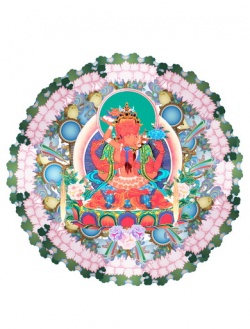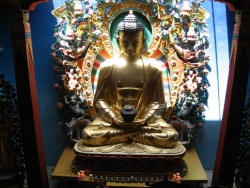Rimé Philosophy
Literally, ‘rimé’ means a ‘non-sectarian’ or ‘non-biased’ view. While some people may think this is related to the idea of all systems being equal, it is actually focused on recognising the value and benefit of multiple points-of-view.
One way to understand this is to consider how we use medicine. There are many medicines and each has the capacity to cure specific types of sicknesses. We do not normally mix our medicines. Instead, we recognise the specific needs of each patient and choose the right medicines for helping them overcome their problems.
In the same way, developing a Rimé philosophy means knowing how each system works, what are its defining characteristics, what are its strengths and how can it be used to alleviate dissatisfaction. While we may have a personally favourite view, a favourite practice or a favourite system, there is no contradiction. We can hold a non-sectarian view while recognising that specific practices and teachings are especially suited for our needs.
Developing the Rimé View
The Rimé view can be understood in variety of ways. At the most fundamental level, Rimé is expressed as a feeling of respect based on faith. This person may or may not know the specific reasons why they respect or believe in the different traditions. Instead she relies on a general sense for the common values that each tradition represents. This level of the Rimé view is often a result of cultural conditioning, positive influences and innate predispositions.
From this foundation of respect, individuals begin to develop a more active, inquisitive level of the Rimé view. This is characterised by an open-minded approach which longs to understand the distinguishing factors of different traditions. There is a sense of wanting to know more, to expand one’s understanding and perspective. It is a process of investigation where the individual actively probes and tests different ideas. In so doing, she resolves doubts and gains greater insight into the strengths and weaknesses of each tradition.
As the individual continues to develop her understanding, she begins to develop a sense of stability in her view. There is an inner resilience that allows her to face criticisms and biased arguments without losing their deeper perspective. She can see how each tradition relates to the others and how they can bring benefit to different types of people. At this level, the individual has developed an unshakeable and genuine respect for pluralistic traditions.
The Rimé Movement
The Rimé View is most often connected with the great masters of the 19th century Jamyang Khyentse Wangpo and Jamgön Kongtrul Lodrö Thaye. The movement that they popularised was however deeply rooted in the work of previous masters.
In the early 16th century, the great master Jonang Kunga Drolchok laid the foundations for the Rimé movement when he travelled extensively throughout many regions, gathering and practicing a wide variety of transmissions, empowerments and pith instructions. He collected these into his great work “The Hundred Teachings of Drolchok” (dolchok tridgya).
Then in the late 16th century, Kunga Drolchok’s reincarnation Kyabdak Drolway Gonpo (Jetsun Taranatha), continued his non-sectarian work by searching out and gathering the transmissions of many nearly extinct lineages. In particular, he placed particular emphasis in preserving the teachings of the Shangpa Kagyu, whose teachings survive to this day due to his efforts.
Khyentse Wangpo and Jamgön Kongtrul further expanded on this work by propagating the teachings widely and publishing many volumes of teachings and commentaries. Jamgön Kongtrul, who is believed to be the reincarnation of Taranatha, was responsible for authoring five treatises known as “The Five Treasuries”. These incredibly vast and comprehensive volumes present a wide range of the teachings, empowerments and rituals of the wisdom traditions developed in Tibet. Why is it important to develop a Rimé philosophy?
The Rimé Institute strives to view all traditions with equal respect and to embrace the Rimé spirit, especially to help students new to Buddhism.
Traditionally, Tibetan Buddhist practitioners place a strong emphasis on the view and instructions passed on through their own lineages. This is crucial in maintaining authenticity of the teachings. Furthermore, many practitioners spend their entire lives in one monastery and devote much time and effort to a thorough training in one tradition, to the exclusion of others. As a result some practitioners are less open to the views and good qualities of other traditions.
The Rimé movement is critical to the advancement of Buddhism on a global scale as it teaches practitioners to respect all traditions, with the goal of creating a sound foundation of Dharma knowledge and practice. With this balanced view comes the ability to assist many people regardless of their beliefs. This is one of the main goals of Rimé and is recognised by many Tibetan masters as a rare and precious view of Buddhism.
In 2003, His Holiness the 14th Dalai Lama recognised Khentrul Rinpoche as a genuine Rimepa master, encouraging him to continue spreading this important movement.


